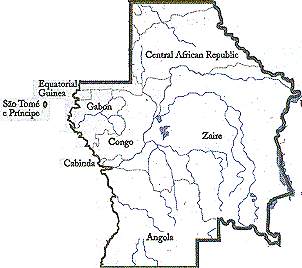CENTRAL AFRICA


CENTRAL AFRICA

<--Fang Reliquary Guardian Figure, Gabon
Painted Wood, 19th Century, 13 3/4 x 7-1/2 in, Private Collection
The most conspicuous geographical characteristic of central Africa is the huge saucerlike area drained by the Zaire River (formerly called the Congo) and its tributaries. To the north are great forests. The south is more sparsely forested, with open and w ooded savannas. The population includes many agriculturists, who keep some animals as well, although, in distinction to eastern and southern Africa, cattle are not herded here. Some peoples of the region practice fishing and trapping; a few are nomadic hu nters and gatherers.
Central Africa has seen the rise of many kingdoms, mostly in the period before European contact. Some, such as the Chokwe and Kongo kingdoms, seem not to have lasted long after the arrival of Europeans. Others, such as the Luba, Kuba, and Lunda, also prec
olonial in origin, have lasted well into this century. All developed royal arts related to the political and religious sources of leadership.
Among many groups, rites of passage became a significant focus for the arts. Masking was associated with an intensive period during which boys were initiated into the knowledge and responsibilities of adulthood. Analogous ceremonies existed for girls, alt hough the use of sculpture was far rarer in their case. Among some groups, special induction ceremonies were held for healers, diviners, ritual experts, blacksmiths, sculptors, singers, and dancers.
Belief in the efficacy of spirit ancestors to aid the living gave rise to sculptures of various types, ranging from portraits to figures that protected the relics of the dead.
 <--Power Figure, Gabon, Zaire, 19th Century, wood and metal with cloth, beads, horns, and leaf, 30 x 10 x 8 in., Alan Stone Gallery
<--Power Figure, Gabon, Zaire, 19th Century, wood and metal with cloth, beads, horns, and leaf, 30 x 10 x 8 in., Alan Stone Gallery
Minkisi, objects of power, are found from the west coast and, among the peoples of southern Zaire, as far as the great lakes. Many, but by no means all, minkisi are in human form yet symbolize spirits. Carved by sculptors and empowered by ritual specialis ts, they are used to neutralize misfortune.
The specialist adds various empowering objects, including mirrors, shells, nails, and feathers, which may be attached over time.
Thus, the sculptor's product becomes an armature for ritual additions over the lifetime of the object's use. Under the specialist's guidance, these power figures may be employed by individuals, families, cults, or the larger community as a link to the sup
ernatural.
<- Back to the Main Index Page
<- To the Clickable Map of Africa ->
<-To Programs and Events in Conjunction with this Exhibition ->
![]()